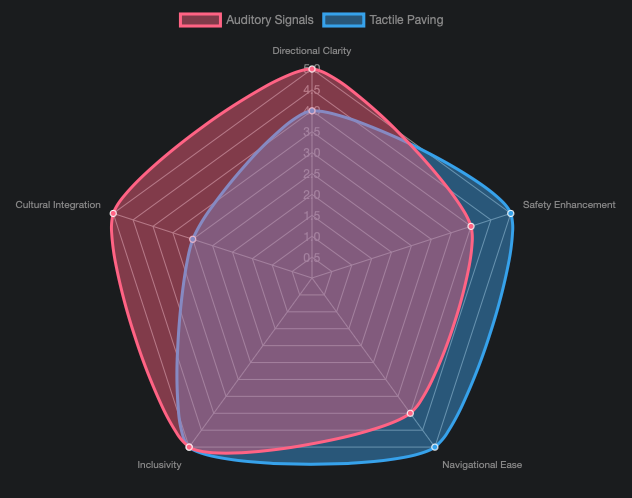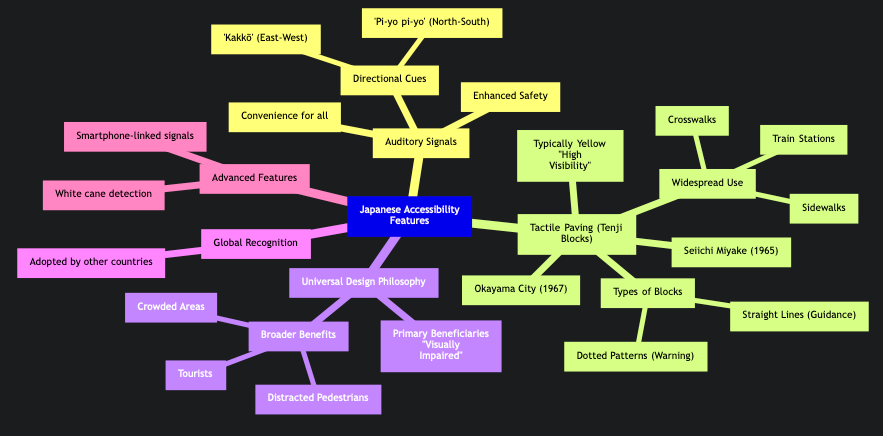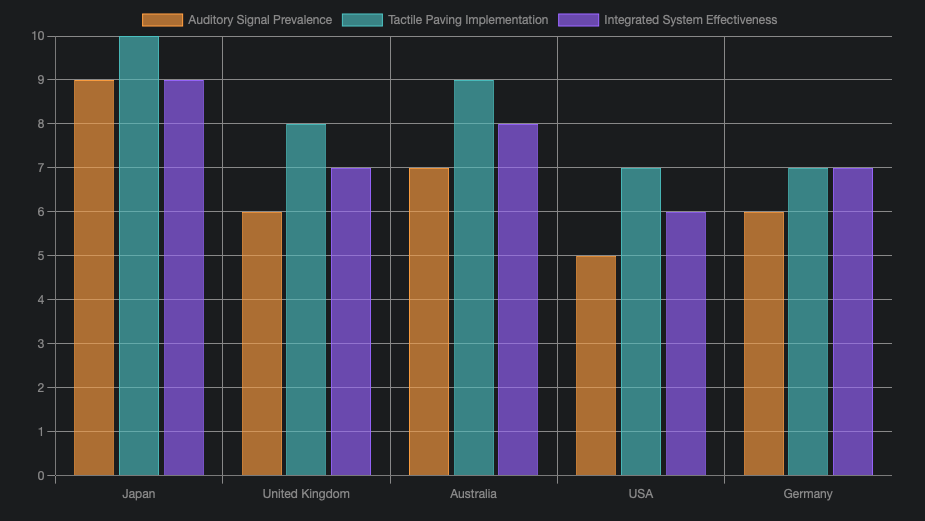Discover how Japan’s innovative use of sound and touch transforms urban navigation for everyone.
60+ Sources
- The Melodies of Safe Passage: Auditory Pedestrian Signals
- The Path You Can Feel: Tactile Paving (Tenji Blocks)
- The Synergy of Sight, Sound, and Touch: Integrated Accessibility
- The Global Impact and Cultural Significance
- Comparative Analysis of Accessibility Features
- Key Elements of Japan’s Accessibility Infrastructure
- Frequently Asked Questions (FAQ)
- Conclusion
- Recommended Further Exploration
- Referenced Search Results
- Auditory Cues: Japan employs distinct bird-like sounds, like “pi-yo pi-yo” (chirp) for north-south and “kakkō” (cuckoo) for east-west crossings, to signal safe passage at intersections.
- Tactile Paving (Tenji Blocks): Yellow, textured tiles provide crucial guidance for visually impaired pedestrians, with straight lines indicating clear paths and dotted patterns marking warnings or intersections.
- Universal Accessibility: This integrated system of sound and touch exemplifies Japan’s commitment to inclusive urban design, benefiting not only the visually impaired but also distracted pedestrians and tourists.
Japan stands at the forefront of urban accessibility, where traffic lights do more than simply change colors. They sing. This unique approach to pedestrian guidance, deeply embedded in the nation’s infrastructure, leverages both auditory and tactile cues to ensure safe and independent navigation for all, particularly those with visual impairments. The system reflects a profound commitment to universal design, transforming ordinary crosswalks into intuitive pathways.
The Melodies of Safe Passage: Auditory Pedestrian Signals
Harmonizing Safety and Direction at Every Intersection
At the heart of Japan’s accessible urban landscape are its innovative auditory pedestrian signals (APS). Unlike conventional traffic lights that rely solely on visual cues, Japanese crosswalks often emit distinct sounds to indicate when it’s safe to cross. These aren’t just random beeps; they are carefully chosen, culturally significant sounds designed to provide clear directional information.
Chirps and Cuckoos: Directional Soundscapes
A remarkable aspect of Japan’s APS is the use of specific sounds to denote crossing directions. For instance, a lively “pi-yo pi-yo” sound, reminiscent of a small bird chirping, is typically associated with north-south crossings. Conversely, an “kakkō” sound, mimicking a cuckoo, commonly signifies east-west crossings. These sounds are not fleeting; they repeat throughout the entire green light phase, continuously reassuring pedestrians that it is safe to proceed. This intelligent distinction allows visually impaired individuals to orient themselves effectively and make informed decisions about their path.

A typical Japanese traffic light, often accompanied by distinct auditory signals.
Beyond Basic Beeps: Evolution of Auditory Signals
While bird-like sounds are prevalent, some systems in Japan are evolving to incorporate alternating signals or even short melodies. This progression aims to further enhance directional guidance and provide richer information to pedestrians. In some instances, the melody or sound might even change during the clearance interval, signaling that the light is about to switch back to red, providing an extra layer of safety. The widespread adoption of these auditory functions is significant, with over 20,000 pedestrian lights in Japan featuring these functions as of March 2020, representing a substantial portion of the country’s traffic infrastructure.
The Path You Can Feel: Tactile Paving (Tenji Blocks)
Guiding Steps with Textured Wisdom
Complementing the auditory signals, Japan extensively utilizes tactile paving, widely known as “Tenji blocks” or “braille blocks.” These distinctive yellow, textured tiles are a ubiquitous feature across Japanese urban environments, found on sidewalks, at crosswalks, train stations, and even within buildings. They serve as a crucial navigational tool for visually impaired individuals, allowing them to traverse complex spaces with confidence and independence.
Unraveling the Tenji Code: Straight Lines and Dots
Tenji blocks employ a simple yet highly effective tactile code:
- Straight lines (guide blocks): These indicate a safe, unobstructed path for continuous movement. They provide a clear direction for pedestrians to follow.
- Beaded or dotted patterns (warning blocks): These signal important information such as intersections, potential hazards, changes in direction, platform edges, or the approach to a crosswalk. They serve as a crucial warning, prompting pedestrians to exercise caution.
These tactile cues are designed to be easily detectable through canes, guide dogs, or even the soles of shoes, making navigation intuitive and safe. The blocks are typically yellow for high visual contrast, although metallic variations are sometimes used for aesthetic purposes in certain areas.

Yellow Tenji blocks guiding pedestrians on a Japanese sidewalk.
A Legacy of Accessibility: The Birth of Tenji Blocks
The invention of tactile paving is credited to Seiichi Miyake in 1965, with the first installation taking place in Okayama City in 1967. This pioneering development marked a significant milestone in accessible design, setting a global precedent. Japan’s commitment to integrating Tenji blocks throughout its infrastructure has made it a world leader in universal design, inspiring similar systems in countries like the United Kingdom, Australia, and Scandinavia.
The Synergy of Sight, Sound, and Touch: Integrated Accessibility
A Holistic Approach to Urban Navigation
The true genius of Japan’s pedestrian guidance system lies in the seamless integration of auditory signals and tactile paving. These two elements work in concert, providing a comprehensive and redundant system of information that empowers visually impaired individuals to navigate urban environments safely and independently. This integrated approach extends beyond mere convenience; it embodies a deeply ingrained philosophy of universal design.
Benefits Beyond Visual Impairment
While primarily designed for the visually impaired, the benefits of this integrated system extend to a much broader audience:
- Distracted Pedestrians: In today’s fast-paced world, many pedestrians are engrossed in their phones or conversations. The distinct auditory cues serve as an unmistakable reminder to pay attention and cross safely.
- Crowded Environments: In bustling areas like Tokyo’s Shibuya Crossing, where thousands of people cross simultaneously, the sounds provide a clear signal amidst the chaos, ensuring everyone knows when to move.
- Tourists and Foreigners: For visitors unfamiliar with local traffic norms, the clear auditory and tactile signals provide intuitive guidance, enhancing their safety and experience.

This radar chart illustrates the perceived strengths of Japan’s auditory signals and tactile paving in various aspects of urban accessibility. Auditory signals excel in cultural integration and immediate directional clarity, while tactile paving provides superior navigational ease and safety for physical guidance. Both contribute significantly to overall inclusivity.
Advanced Accessibility Innovations
Japan continues to push the boundaries of accessibility. Recent advancements include smartphone-linked traffic lights that can transmit signal status directly to a visually impaired user’s device. Some systems can even detect stickers on white canes, providing personalized audio information about the light’s color. These innovations demonstrate an ongoing commitment to leveraging technology for universal access.
The Global Impact and Cultural Significance
A Model for Universal Design Worldwide
Japan’s pioneering work in accessible urban design has garnered international recognition and serves as a model for cities worldwide. The iconic sounds and visible Tenji blocks are not just practical tools; they have become ingrained in Japanese cultural identity, often referenced in media and pop culture.
Cultural Resonance: Beyond Functionality
The bird-like sounds, particularly the “pi-yo pi-yo” and “kakkō,” are more than just functional signals; they evoke a sense of familiarity and even nostalgia for many Japanese citizens. They are a subtle yet pervasive part of the urban soundscape, adding a unique character to the experience of navigating Japanese cities. This cultural integration highlights how accessibility features can become seamlessly woven into the fabric of daily life.
mindmap
root[“Japanese Accessibility Features”]
AuditorySignals[“Auditory Signals”]
DirectionalCues[“Directional Cues”]
PiyoPiyo[“‘Pi-yo pi-yo’ (North-South)”]
Kakko[“‘Kakkō’ (East-West)”]
Safety[“Enhanced Safety”]
Convenience[“Convenience for all”]
TactilePaving[“Tactile Paving (Tenji Blocks)”]
Inventor[“Seiichi Miyake (1965)”]
FirstInstallation[“Okayama City (1967)”]
Types[“Types of Blocks”]
StraightLines[“Straight Lines (Guidance)”]
DottedPatterns[“Dotted Patterns (Warning)”]
Material[“Typically Yellow #quot;High Visibility#quot;”]
Locations[“Widespread Use”]
Sidewalks[“Sidewalks”]
Stations[“Train Stations”]
Crosswalks[“Crosswalks”]
UniversalDesign[“Universal Design Philosophy”]
VisuallyImpaired[“Primary Beneficiaries #quot;Visually Impaired#quot;”]
BroaderBenefits[“Broader Benefits”]
DistractedPedestrians[“Distracted Pedestrians”]
Tourists[“Tourists”]
CrowdedAreas[“Crowded Areas”]
GlobalRecognition[“Global Recognition”]
InternationalAdoption[“Adopted by other countries”]
AdvancedFeatures[“Advanced Features”]
SmartphoneIntegration[“Smartphone-linked signals”]
CaneDetection[“White cane detection”]

This mindmap visually outlines the comprehensive nature of Japan’s pedestrian accessibility features, highlighting the interconnectedness of auditory signals, tactile paving, and the overarching philosophy of universal design.
Comparative Analysis of Accessibility Features
Beyond Japan: A Look at Global Approaches
While Japan stands out for its integrated and culturally resonant approach, it’s insightful to compare its accessibility features with those found in other parts of the world. This comparison highlights Japan’s unique strengths and the areas where global efforts are converging.

This bar chart compares the estimated prevalence and effectiveness of auditory signals, tactile paving, and integrated system effectiveness across different countries. Japan consistently scores highly, demonstrating its leadership in comprehensive pedestrian accessibility.
The Evolution of Pedestrian Signals
The journey of pedestrian signals from simple visual indicators to sophisticated multi-sensory systems is a testament to ongoing efforts to make cities more equitable. Japan’s experience provides valuable lessons, particularly in how cultural elements can be leveraged to enhance functional design, creating an environment that is not just accessible, but also uniquely charming.
For a deeper dive into the sounds of Japanese crosswalks, you can watch this insightful video:
This video provides a detailed explanation of the various types of pedestrian crossings with sound in Japan, showcasing how these systems are evolving.
Key Elements of Japan’s Accessibility Infrastructure
A Consolidated View of Pedestrian-Centric Design
To summarize, Japan’s commitment to pedestrian accessibility is evident in a multi-faceted approach, combining cutting-edge technology with thoughtful urban planning. The table below consolidates the key elements discussed, highlighting their purpose and impact.
| Feature | Primary Purpose | Mechanism | Key Benefits | Global Recognition/Impact |
|---|---|---|---|---|
| Auditory Pedestrian Signals (APS) | Indicate safe crossing times and direction. | Distinct bird-like sounds (“pi-yo pi-yo” for N-S, “kakkō” for E-W) repeat during green light. | Assists visually impaired, alerts distracted pedestrians, clarifies direction. | Unique, culturally integrated, inspires similar systems. |
| Tactile Paving (Tenji Blocks) | Provide physical guidance and warning for visually impaired. | Yellow textured tiles: straight lines for paths, dotted patterns for warnings/intersections. | Enables independent navigation, felt by cane/shoe, prevents accidents. | Invented in Japan, adopted worldwide (UK, Australia). |
| Advanced Integrated Systems | Enhance guidance through smart technology. | Smartphone-linked signals, white cane detection for audio feedback. | Personalized information, increased safety through technology. | Continuous innovation, model for future urban accessibility. |
Frequently Asked Questions (FAQ)
Clarifying Common Queries About Japan’s Pedestrian Systems
What are the specific sounds used at Japanese crosswalks?
The most common sounds are a chirping “pi-yo pi-yo” for north-south crossings and a cuckoo call “kakkō” for east-west crossings. Some locations may also feature short melodies like the children’s song “Tōryanse.”
Who invented Tenji blocks and when?
Tenji blocks were invented by Seiichi Miyake in 1965. The first installation occurred in Okayama City, Japan, in 1967.
Are these systems only for visually impaired people?
While primarily designed for visually impaired pedestrians, the auditory signals and tactile paving also benefit sighted individuals by providing clear cues in busy or distracting environments, and helping tourists navigate unfamiliar areas.
How does Japan’s approach to accessibility compare to other countries?
Japan is widely recognized as a pioneer in urban accessibility, particularly due to its widespread and integrated use of both auditory signals and tactile paving. Many countries have adopted similar tactile paving systems inspired by Japan’s innovation.
Conclusion
Japan’s Blueprint for an Inclusive Urban Future
Japan’s approach to pedestrian traffic signals is a testament to its forward-thinking urban planning and unwavering commitment to accessibility. By seamlessly integrating distinctive auditory cues with tactile paving, the nation has created an environment where navigating busy streets is intuitive, safe, and inclusive for everyone. These cheerful sounds and textured pathways are more than just functional elements; they are symbols of a society that values the independence and dignity of all its citizens, setting a remarkable global standard for universal design.
Recommended Further Exploration
Dive Deeper into Japan’s Innovative Urban Landscape
- Explore the historical evolution of universal design principles in Japan.
- Discover how smart city initiatives in Japan are further enhancing accessibility.
- Investigate discussions around noise pollution and auditory signals in Japanese cities.
- Compare design principles of tactile paving in other countries versus Japan.
Referenced Search Results
Sources for This Comprehensive Overview
japanupclose.web-japan.org
Japan Up Close – Yellow guide paths for the visually impaired – Tenji blocks
samuraitours.com
Follow the Yellow Brick Roads – Japan’s Tactile Paving Blocks – Samurai Tours
japantimes.co.jp
Yellow brick roads: How Japan’s tactile paving aids solo travel – The Japan Times
en.wikipedia.org
japanupclose.web-japan.org
Japan Up Close – Tenji Blocks: The Braille Blocks that Revolutionized Accessibility in Japan
adatile.com
Seiichi Miyake Make Truncated Domes – ADATILE
english.kyodonews.net
Tactile paving in Japan enhanced with audio guidance – Kyodo News
japanupclose.web-japan.org
Japan Up Close – Traffic lights in Japan emit bird-like sounds for pedestrians
apsguide.org
Accessible Pedestrian Signals (APS) in Japan – APSGuide.org
e-housing.jp
Japan’s traffic lights are different – E-housing.jp
guidable.co
Japanese “Pushbutton Crosswalk Signals” – Guidable
mainichi.jp
Smartphone-linked traffic lights helping guide visually impaired in Japan – The Mainichi
blog.gaijinpot.com
Are Traffic Lights in Japan Confusing? – GaijinPot
gogonihon.com
Understanding accessibility in Japan
jbic.go.jp
Profile | JBIC Japan Bank for International Cooperation
cnrj.cnic.navy.mil
soranews24.com
Be kind to blind pedestrians by choosing where you step when walking through the snow in Japan
japantravelplanning.com
Japan Traffic Lights Guide: More Than Red, Yellow, and Green
soundtransit.org
zedge.net
japan crosswalk Ringtones – Free by ZEDGE™
japantravelpros.com
Accessible Travel in Japan | Japan Travel Pros
kshouse.jp
The Silent Language of Tenji Blocks (yellow lines in Japan)
reddit.com
japan-guide.com
Sound of green traffic lights. – japan-guide.com forum
english.jaf.or.jp
japantoday.com
Are traffic lights in Japan confusing? – Japan Today
villagehiker.com
japan-guide.com
Sound of green traffic lights. – japan-guide.com forum
japan-guide.com
Basic Guide to Accessible Travel
pce-instruments.com
Sound Level Meter / Noise Level Meter PCE-TSM 5 | PCE Instruments
soundtransit.org
Stride bus rapid transit | Project map and summary | Sound Transit
freesound.org
reddit.com
r/japanlife on Reddit: Pedestrian crossing in Japan
english.jaf.or.jp
jbic.go.jp
Profile | JBIC Japan Bank for International Cooperation
ablr360.com
What Japan Taught Me About Accessibility – Ablr
roll2explore.com
Japan’s Wheelchair Accessibility Rating
yellowcapped.com
Red, Yellow, Blue. The traffic lights of Japan!
japan.travel
Accessible Tourism: Opening Doors for All Visitors to Japan | Blog
ncrtm.ed.gov
[PDF] AUDIBLE TRAFFIC SIGNALS IN JAPAN AND AUSTRALIA:
ja.wikipedia.org
npa.go.jp
soranews24.com
This new convenience store isn’t so convenient for the blind…
reddit.com
r/japanlife on Reddit: What exactly are the rules for pedestrian …
reddit.com
r/japan on Reddit: Clear copy of the Tokyo pedestrian crossing sound
open.spotify.com
Tokyo, Japan City Side Street Ambience with Light Traffic …
baswana.com
Commercial Sound Absorbing Acoustic Plaster | BASWA Phon
truckymods.io
AI Traffic Mods for American Truck Simulator – TruckyMods
japantravel.navitime.com
Guide To Traffic Signs in Japan | Japan Travel by NAVITIME – Japan …
soundsnap.com
Pedestrian Crossing Sound Effects Download | SFX Library | Soundsnap
electronics360.globalspec.com
Watch: Remote sensing under the sea with light and sound | Electronics360
boingboing.net
How to avoid entrapment at traffic stops (video) – Boing Boing
yavajapan.com
How Accessible Is Japan For Blind Or Visually Impaired Travelers?
mynoise.net
Background Noises • Ambient Sounds • Relaxing Music | myNoise ®
transport-pf.or.jp
Welcome to the Web site of TRANSPORT IN JAPAN
japan-top-10.com
10 Road Signs Pedestrians In Japan Must Recognize
www2.tocoo.jp
Road Signs in Japan Explained | Guide of Travel in Japan
dcp.ucla.edu
en.wikipedia.org
Road signs in Japan – Wikipedia
thejapans.org
Japanese pedestrian crossings – The Japans
Last updated September 9, 2025

